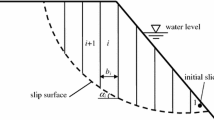Conclusions
1. The computation of earth slopes in accordance with current standard documents in cases where soils behave rheologically will make it possible to evaluate their stability only for the first limiting state with the condition that the strength characteristics correspond to the ultimate long-term strength.
2. In contrast to the standard method, the computational method that we have developed will make it possible to evaluate simultaneously the stability of earth slopes on the basis of the first and second limiting states; this is particularly important when structures that interest with a creep-prone slope are present.
3. The time to failure of slopes, which is calculated using the long-term-strength curve, is appreciably lower as compared with that predicted from the method that we have developed, which takes into account the interrelation of the stress and strain states.
Similar content being viewed by others
Literature cited
N. A. Tsytovich and Z. G. Ter-Martirosyan, Fundamentals of Applied Geomechanics in Construction [in Russian], Vysshaya Shkola, Moscow (1981).
S. S. Vylov, Rheologic Bases of Soils Mechanics [in Russian], Vysshaya Shkola, Moscow (1978).
N. N. Maslov, Soil Mechanics in Construction Practice (Earth Slides and Their Prevention) [in Russian], Stroiizdat, Moscow (1977).
Yu. K. Zaretskii and V. N. Lombardo, Statics and Dynamics of Earth Dams [in Russian], Energoatomizdat, Moscow (1938).
Construction Rule and Regulation 2.02.02-85. Foundation Beds for Water-Development Works [in Russian].
Yu. K. Zaretskii, Lectures on Modern Soil Mechanics [in Russian], Rostov State Univ. Rostov-na-Donu (1989).
Yu. K. Zaretskii and V. N. Vorob'ev, "Evaluation of the long-term stability of displacement rates in creepprone slopes," Proceedings of the Sixth All-Union Symposium on Soil Rheology [in Russian], Riga (1989).
M. N. Gol'dshtein and A. Ya. Turovskaya, "Theory of the development and attenuation of the creep process," Probl. Geomekh., No. 7, 140–147 (1973).
G. M. Lomize, A. A. Muzafarov, and V. Yu. Novikov, "Long-term strength of clayey soils in the core of a high-head dam and in the foundation beds of water-development works," Gidrotekh. Stroit., No. 4, 17–23 (1975).
L. Schukle, Rheologic Problems of Soil Mechanics [Russian translation], Stroiizdat, Moscow (1976).
A. A. Muzafarov, "Effect of creep on the deformability and strength of clayey soils in water-development works and their foundation beds," Author's Abstract of Candidate's Dissertation, Technical Sciences, Moscow (1972).
Construction Rule and Regulation 2.06.05-84. Dams Formed from Soil Materials [in Russian].
V. M. Kirillov and L. V. Kirllova, Long-term strength of soils and slope stability, Soil Mechanics, Beds, and Foundations [in Russian], Leningrad (1980), pp. 49–56.
G. S. Zolotarev, "Geologic-engineering problems of the construction of water-storage power plants," Tr. Gidroproekta, No. 82, 82–98 (1982).
Author information
Authors and Affiliations
Additional information
Translated from Osnovaniya, Fundamenty i Mekhanika Gruntov, No. 3, pp. 23–27, May–June, 1990.
Rights and permissions
About this article
Cite this article
Zaretskii, Y.K., Vorob'ev, V.N. Evaluation of the long-term stability of creep-prone slopes. Soil Mech Found Eng 27, 125–132 (1990). https://doi.org/10.1007/BF02306671
Issue Date:
DOI: https://doi.org/10.1007/BF02306671




